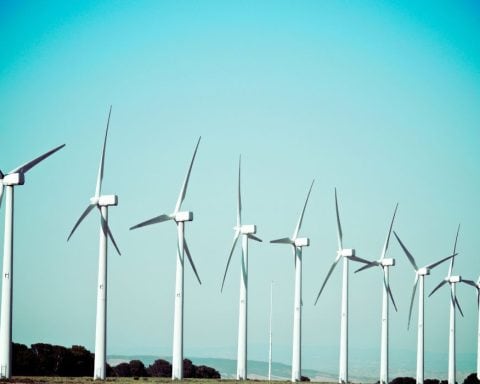The road to Colombia’s energy transition runs through La Guajira. The northern department spilling into the turquoise Caribbean Sea is known for its majestic sand dunes, haunting desert landscapes and remote fishing outposts inhabited by Indigenous Wayuu communities.
And now, it is the backdrop to a key plank in the South American country’s dramatic pivot to a greener economy.
When President Gustavo Petro took office in 2022, he made the energy transition the cornerstone of his mandate, turning heads by drawing comparisons between the world’s addictions to cocaine and oil. His government says it will not issue any new oil and gas exploration contracts – a first for a major petroleum-producing country – and at COP28 in December in Dubai it joined the international alliance calling for a treaty to end the use of fossil fuels.
“My own society would say, ‘How would the president produce such economic suicide?’ given that we depend on oil and coal. But this is not economic suicide,” he said at the climate summit. “We are talking here about an ‘omnicide,’ the risk of extinction of life on the planet. Here we are avoiding ‘omnicide’ on planet Earth. There is no other way; the rest are illusions.”
This is not an inconsequential position to take, considering how heavily Colombia relies on its exports of oil, coal and gas.
Oil accounts for roughly 2% of Colombia’s gross domestic product (GDP), while oil, gas, coal and other resources from extractive industries represent about 55% of the value of its exports. “It’s a double challenge,” admits Javier Campillo Jiménez, the newly minted vice-minister of energy and mines. “This is the first time in the country where we’re talking about a just energy transition.”
Enter La Guajira, struggling with rampant levels of poverty and poor infrastructure and home to a major polluting coal mine. The area is part of the 52% of Colombia that isn’t connected to the central electrical grid. Here, most people power their lives through diesel that is subsidized by the government. But with high levels of solar radiation and powerful knots of wind, the region is ripe to lead a renewables renaissance.
By early 2024, La Guajira will be home to some 123 “energy communities” – small pockets that live and power themselves off “microgrids” fuelled by hydro, wind, geothermal and solar sources. The grids will be public infrastructure, administered and maintained by the communities, which can sell the energy to other customers or to the utility, generating local revenue. “We’re working with communities so they can actually be in charge of their own energy systems,” Campillo says.
The potential is huge, says Juanita Giraldo Quiroz, an environmental engineer who spearheaded an energy-community pilot project. “It could turn into the motor of the energy transition,” she says of La Guajira.
We’re working with communities so they can actually be in charge of their own energy systems.
- Javier Campillo Jiménez, Colombia vice-minister of energy and mines
This is an important piece of the energy puzzle for Colombia, which has been heralded by the International Energy Agency (IEA) as an “inspiring example” of a fossil-fuel-producing country that is charting a decarbonization course with equity in mind. The second largest country in South America by population – and a coal powerhouse in the region – is aiming to cut its greenhouse gas emissions by 51% by 2030. It is leaning into geothermal, carbon capture and hydrogen and using tax incentives and retraining programs to shift its extractive industry from drilling for fossil fuels to digging for minerals like lithium, nickel and cobalt that are the building blocks of cleaner energy. Colombia is also aiming to be coal-free by 2030, Campillo says. Renewables, mostly hydro and bioenergy, such as firewood and waste, represent 29% of its consumption, well above the IEA average. They made up 75% of the electricity generation in 2021, compared to an IEA average of 30%.
For now, the country is engaged in a delicate balancing act, as the gas reserves it depends on for its transition dwindle and it starts to feel the economic pinch of a decarbonizing world. While the chairman of Ecopetrol, the state-run energy company, has said it has to increase its oil and gas production in order to fund the country’s energy transition, net revenue has been dropping, by 47% in the third quarter of 2023, because of the plunging price of crude on the international market. Indeed, Colombia could lose up to 10% of its export revenues and 8% of its GDP by 2050 as the planet shifts away from fossil fuels, according to the World Bank.
“We are convinced that strong investment in tourism, given the beauty of the country, and the capacity and potential that the country has to generate clean energy could, in the short term, perfectly fill the void left by fossil fuels,” Petro told reporters in Davos last year.
The World Bank and other domestic and international energy experts maintain that wide-ranging reforms will be necessary to make up for fiscal shortfalls and finance climate action. The Colombian-based Centro Regional de Estudios de Energía (CREE) produced a road map to carbon neutrality last year. It highlights the need for “transformational, not incremental” changes to the country’s electricity system, which will have to boost its low-carbon generating capacity fivefold to meet net-zero by 2050. Putting a price on carbon, and greater investment in new technologies, will be crucial, the CREE report notes.
“I don’t think the goals are that far off,” Quiroz says. “What it needs is a bit of a boost.”
Campillo calls Colombia’s plans “ambitious, but also necessary.” Although Colombia represents only 0.6% of global carbon dioxide emissions, its vulnerability to climate change is becoming increasingly acute, as it faces a growing number of floods and deadly landslides. By 2050, the number of people affected by floods is expected to triple, according to a recent World Bank report, while the number of days with temperatures eclipsing 35°C will increase sixfold.
The energy transition in Colombia is occurring under the stark glare of growing violence against those who stake out positions in defence of land and the environment. Colombia has become the most dangerous territory in the region. According to Global Witness, 60 land and environmental defenders were murdered in Colombia in 2022, nearly double the number from the previous year.
We are convinced that strong investment in tourism ... could, in the short term, perfectly fill the void left by fossil fuels.
- Gustavo Petro, Colombia president
While there is hope that Petro, who is the first leader to specifically pledge to protect land defenders – and has promised to impose stricter environmental controls for extractive projects – may help crack down on the violence, the reality on the ground remains dangerous, says Oscar Sampayo, an environmentalist and lawyer. He says that most of the violence targets people who are contesting deforestation for monoculture plantations, in particular coca plants, along with those who disrupt routes that traffic processed cocaine. But lives are also lost in opposition to large mining projects. And while social-movement and civil organizations are buoyed by the government’s pledge to put the brakes on new extractive fossil fuel projects, Sampayo expresses concern that limiting projects could have the unintended consequence of creating more stress on the 200-odd oil and gas contracts that currently exist, as contractors push to cross environmental assessment hurdles and secure permits on expedited timelines.
“The rationale of these companies is to maximize at all cost, and here ‘at all cost’ includes threats and the use of violent strategies. That’s what we’re worried about,” he says.
Questions also remain about what a “just transition” actually means. “We need clarity on if this means democratization of energy, or if it’s going to be the same 20 companies controlling energy in Colombia,” Sampayo says.
Quiroz, the environmental engineer, sees a golden opportunity with the microgrid-powered energy communities, if done correctly. She says that large-scale projects are becoming increasingly untenable because of fierce local opposition, in particular from Indigenous communities who consider growing encroachment by companies wanting to set up wind farms as an incursion on their ancestral territory. Earlier this year, for example, Enel Colombia cancelled a large wind-farm project in La Guajira following two years of protests and blockades by some Wayuu communities who said they had been neither consulted nor compensated, unlike other Indigenous communities.

For Quiroz, smaller-scale projects will be key, because they intrinsically come with local empowerment and participation. “When we’re talking about the energy transition, it’s not just about a focus on decarbonization,” she says. Other objectives are critical, such as shifting energy users from passive to active consumers who are part of the grid. “Our population is increasing, and so is the demand for energy,” she says. “Rather than focusing on generating and generating and generating, why not focus on using energy more efficiently, or having people generate it themselves at home,” she says. “If you have a user who is empowered, who is part of the electrical system, then their point of view is different.”
That said, she says more has to be done by the government to ensure that the energy communities have the right regulations and support to be made reality. Campillo, the vice-minister, says that’s exactly what his team is focused on. He acknowledges the social, environmental and technical challenges that have hampered the transition in recent years, including issues around permitting, a lack of capacity or local expertise, corruption, and the shifting economic feasibility of some of the projects. But he says Colombia is on track to generate one gigawatt of renewable power by 2026 through its community strategy, with another five gigawatts coming from larger ventures.
“We’re not looking at importing our energy transition. We’re looking at developing the necessary skills and the necessary capacity in the country so we can build our own,” he says.





